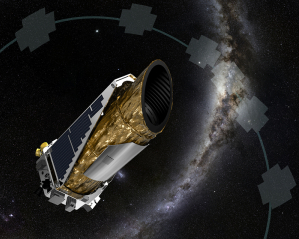
NASA announced back in 2013 that its Kepler space telescope could not be repaired. However, it has started to work again, bringing out the discovery of a new "alien planet."
According to a statement issued by the Harvard-Smithsonian Center for Astrophysics, or CfA, Kepler discovered a new super-Earth using data collected during its "second life." Lead author and graduate student Andrew Vanderburg elaborated on the significance of the findings.
"Like a phoenix rising from the ashes, Kepler has been reborn and is continuing to make discoveries," Vanderburg said. "Even better, the planet it found is ripe for follow-up studies."
According to CfA, the Kepler spacecraft detects planets by looking for transits, which happens when "a star dims slightly as a planet crosses in front of it." CfA noted that Kepler had to "maintain a steady pointing" in order to get precise "brightness measurements."
According to NASA, the newly discovered exoplanet is 2.5 times the diameter of the Earth. The space agency named the planet HIP 116454b.
"The discovery was confirmed with measurements taken by the HARPS-North spectrograph of the Telescopio Nazionale Galileo in the Canary Islands, which captured the wobble of the star caused by the planet's gravitational tug as it orbits," NASA said.
NASA added that HIP 116454b "follows a close, nine-day orbit around a star that is smaller and cooler than our sun, making the planet too hot for life as we know it." As for its location in the cosmos, NASA explained that this alien planet was near the Pisces constellation, 180 light-years away from Earth.
Kepler was made at a cost of around $600 million and launched back in 2009. NASA feared that the space telescope's useful life ended last year after the space agency discovered that two of its four gyroscope-type reaction wheels didn't work well, which meant it could not maintain and capture steady measurements from space.
"Rather than giving up on the stalwart spacecraft, a team of scientists and engineers crafted a resourceful strategy to use pressure from sunlight as a 'virtual reaction wheel' to help control the spacecraft," NASA said.
The CfA explained in its statement how its team managed to extract useful data that led to the alien planet discovery.
"Vanderburg and his colleagues developed specialized software to correct for spacecraft movements, achieving about half the photometric precision of the original Kepler mission," CfA wrote.
Based on the data retrieved, CfA mentioned that HIP 116454b was a "super-Earth," noting that it was in "a class of planets that doesn't exist in our solar system."
"The average density suggests that this planet is either a water world (composed of about three-fourths water and one-fourth rock) or a mini-Neptune with an extended, gaseous atmosphere," CfA wrote.
According to NPR, Kepler has been responsible for discovering 996 planets and more than 4,100 planet candidates. Back in February, NASA unveiled 715 newly discovered planets.
Kepler/K2 Project scientist Steve Howell of NASA's Ames Research Center in California commented on the data gathered from Kepler's mission.
"The Kepler mission showed us that planets larger in size than Earth and smaller than Neptune are common in the galaxy, yet they are absent in our solar system," Howell said. "K2 is uniquely positioned to dramatically refine our understanding of these alien worlds and further define the boundary between rocky worlds like Earth and ice giants like Neptune."







![[Exclusive Interview] Evangelist Stephen Tong exhorts the Chinese church to return to the foundations of reformed faith](http://dev.gospelherald.com/media/cache/thumbnail/7/23/72340sp_273w_150h_1x_1y.png)